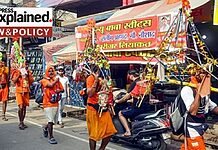‘Heat wave’ to ‘severe heat wave’ conditions have prevailed in North and North-West India on almost all days in June so far. Southwest Monsoon, which started early in Kerala, has advanced to Maharashtra, but the maximum temperature in the plains of North India remained at 45-47 degrees Celsius.
Monsoon Basics and Dates
The June-September southwest monsoon brings more than 70% of India’s annual rainfall. Climatically, the Monsoon arrives through the Andaman Sea in the third week of May and progresses inland through Kerala, with a normal onset date of June 1.
It then advances in spurts – generally, the advance is rapid up to central India, after which it slows down. Monsoon generally reaches North Uttar Pradesh, Delhi and surrounding areas by June end and covers the entire country by July 15.
An early or timely onset of monsoon does not guarantee good rainfall or its distribution across the country in a four-month season. A late start does not mean below-average rainfall for the entire season.
Rainfall in the country from June to September depends on many factors. It shows the natural annual variation that makes each monsoon different. Along with the amount of rainfall, its distribution is also important.
The India Meteorological Department (IMD) has predicted ‘above normal’ rainfall this season. In terms of volume, this is expected to be 106% of the long-term average of 880 mm (1971-2020 data).
The ‘above normal’ rainfall is mainly attributed to the soon-to-emerge La Nina conditions, which are known to positively affect the Indian monsoon, and the positive phase of the Indian Ocean Dipole (IOD).
Good start, followed by drought
Monsoon arrived in the Andaman Sea and Nicobar Islands on May 19 and hit the Kerala coast on May 30, two days ahead of its usual date. It reached parts of Nagaland, Manipur, Mizoram, Arunachal Pradesh and Tripura six days earlier — marking a simultaneously rare but unheard of start in Kerala and much of eastern India.
After 30 May, Monsoon will advance every day and cover large parts of Andaman & Nicobar Islands, Kerala, Lakshadweep, Mahe, Tamil Nadu, Puducherry, Karnataka, Telangana and Andhra Pradesh and Maharashtra by 10 June.
This was a surplus of 36.5 mm or 3% across India as on June 10. Monsoon arrived three to five days earlier in these states and UTs.
2 branches of Monsoon
The India Meteorological Department announced that it started in Kerala on May 30, the same day the monsoon advanced over much of eastern India, mainly due to Cyclone Remal, which made landfall on the coasts of West Bengal and Bangladesh on May 26 and its remnants traveled further.
Domestically. Assam, Meghalaya, Tripura and Sikkim received heavy to very heavy rains leading to floods, mudslides and landslides in early June.
Strong westerly/southwesterly winds from the Arabian Sea triggered monsoon rains in the southern peninsula in early June. Several cyclonic circulations provided favorable conditions along the west coast till 10 June, after which the lack of synoptic systems led to the loss of steam from the southwesterly winds leading to a weakening of the monsoon.
“In the absence of strong easterly winds, the Bay of Bengal branch of monsoon has not been able to advance (further). We have to wait for a new pulse and monsoon trough to establish itself so that the monsoon system regains strength,” said IMD’s senior meteorologist T. Sivananda Bhai.
When is it likely to rain?
Monsoon is currently intense over sub-Himalayan regions of Arunachal Pradesh, Assam, Meghalaya, Sikkim, Nagaland, Manipur, Mizoram, Tripura and West Bengal.
Rainfall will increase over Konkan and North Karnataka later this week. But all other parts of the country will remain dry.
“We expect the monsoon to revive by the end of June,” Bai said. However, it remains uncertain when the monsoon will begin in North India.
According to the Meteorological Department, the heat wave will subside and rains will continue in Jammu and Kashmir and Himachal Pradesh this week. Warm nights and hot conditions will persist over Uttar Pradesh, Haryana, Delhi and Chandigarh till Wednesday, but will subside thereafter. Rainfall in June will end up below normal across the country.









